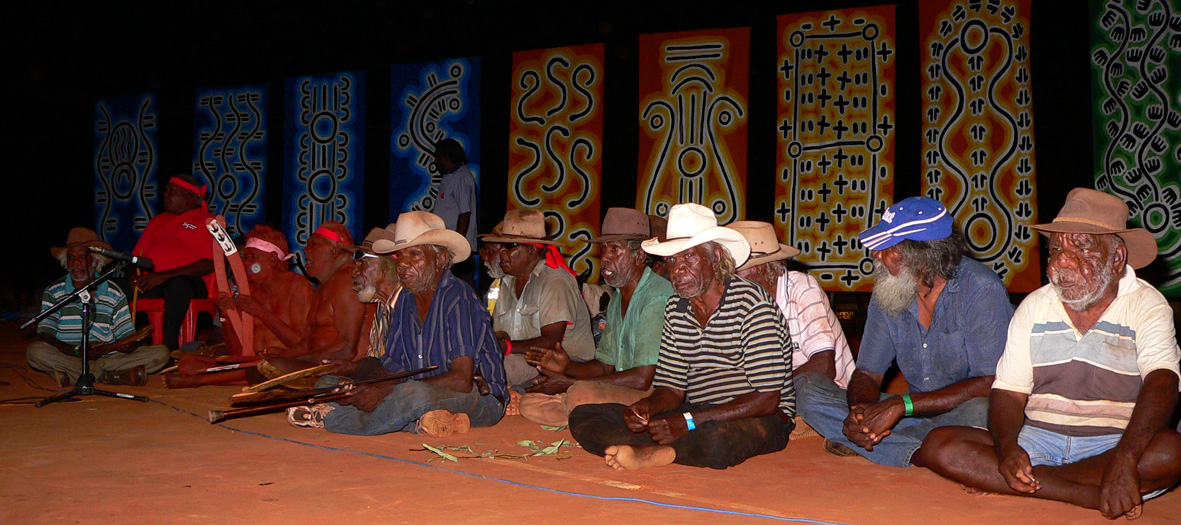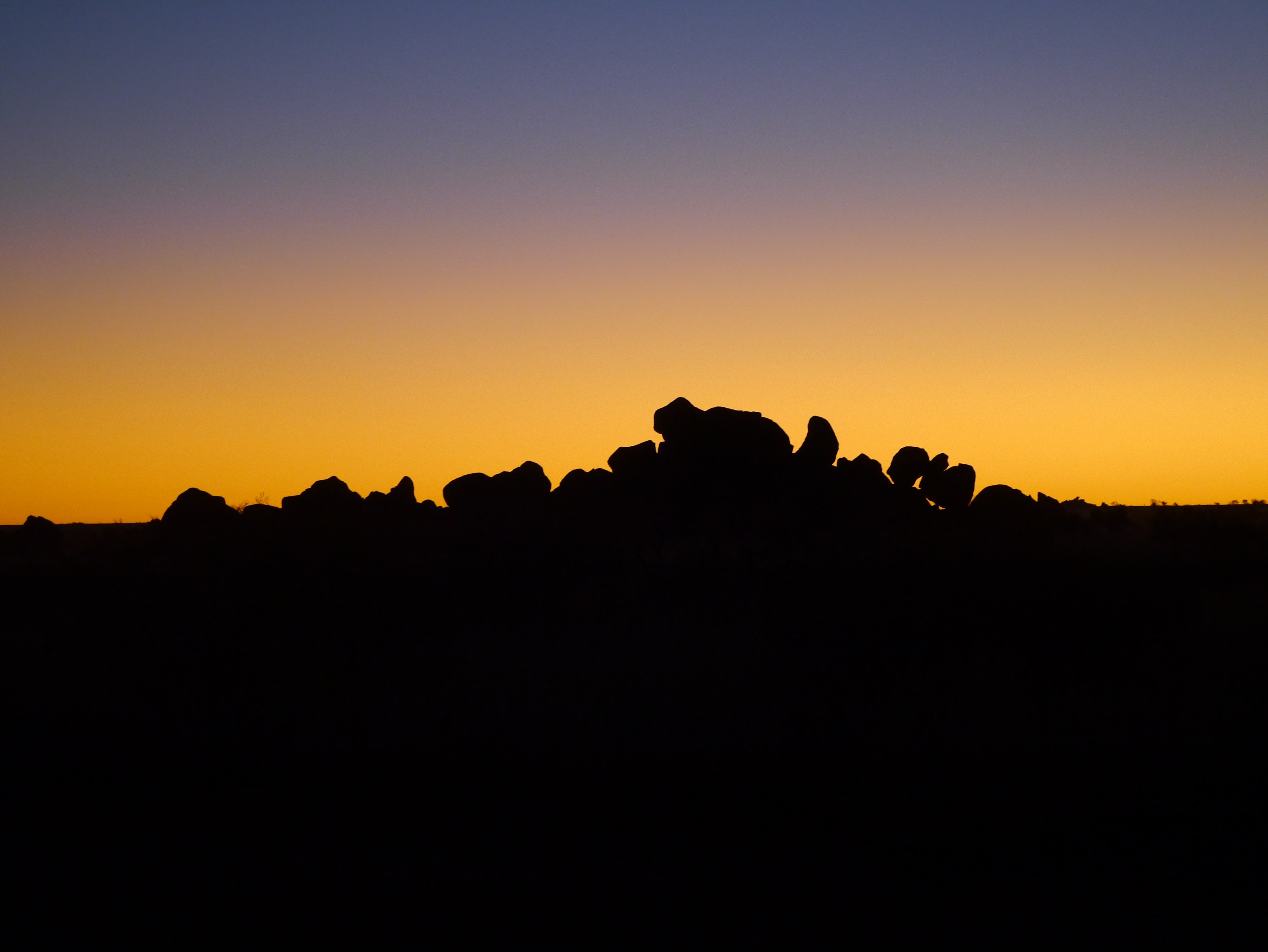Milpirri Banner - JANGANPA (Brush Tailed Possum)
Dreaming Design
Janganpa (Common Brush Tailed Possum). In this banner, the E shapes represent possum tracks, the circles represent three places that the possum ancestor visited, and the line represents the journey path of the possum people.
Place
Yartalu Yartalu (the Granites). Victor Jupurrula Simon states that the possum went to three places, and then a big mob came back fighting at the Granites.
Belonging to Skin Groups
Jupurrula, Jakamarra, Napurrurla and Nakamarra (Red Group)
Drawn By
Victor Jupurrula Simon (dec), 2012
Family
To learn more about Janganpa speak with Simon and Cook families, or Marylyn Peters.
Artist Profile
Victor Jupurrula Simons. Jupurrula was a Warlpiri artist and an active figure in the Lajamanu community (NT), which he represented for the Aboriginal Torres Strait Islander Commission (ATSIC). Born at Yarturlu-yarturlu in 1945 of the Warlpiri tribe and language, he lived at Lajamanu and his country is Yarturlu-yarturlu – the Granites gold mine. His father Pirlarla Jakamarra, whom Victor described as 'boss of his countrymen’, organised Aboriginal people to work at Granites goldmine in the ’30s. A few years after Victor was born, his father was killed when the army greatcoat he always wore became stuck in the wheels of the crusher. Victor was thirteen years old when he came to Lajamanu. He was one of the Lajamanu representatives for ATSIC. He painted Pirlarla, Ngurlu (bush seeds for grinding into damper), Laju ('Witchetty in Gumtree’) Dreamings. Jupurrula worked with his wives Kitty, Pampirriya and Agnes Napanangka, and started painting in 1986. He won a prize at the Tennant Creek Art Award in 1988.
Source: Trove - National Library of Australia
Latin
Trichosurus Vulpecula
Biology
'Janganpa’ (Common Brush Tailed Possum) were once frequently found across much of Warlpiri and neighbouring country but have become locally extinct in recent years. It is speculated that this extinction may be due to feral cat predation and the changes to their habitat caused by the introduction of cattle and other feral animals.
Read about brush tailed possum biology and conservation status - Story
Dreaming Story
In this story Janganpa (a lone possum man) runs from Piyayi in Pintubi country. He runs a long way to east looking for Alyawarri and Wankangurru tribes to help him fight his own people. He recruits Yawakiyi (big black plums) and Yiwirnti (small green plums) to help. They travel back to the Granites where the following scene occurs as told by Nakjut Barbara Gibson Nakamarra in 1984:
“From the Yawakiyi black soup came out a butterfly, a yinilyapilyapi flower and wikirri leaves. Possum takes the flower and the leaves and starts walking again with the eastern possums who joined him. The butterfly follows the flower, its food, and the yarrindakurdaku bird flies sideways. The flower dried, but the leaves gave new seeds which grew into a new Yawakiyi people. We dance all this in a yawulyu.
Coming to the Mirnangi soak, Janganpa explains to the new plums and his fellow possums how to enter the country of his people that he wants to attack. First they have to split into two groups and meet him in Yurnturru. He goes alone through the quickest way. Stopping at a ghost gum, called since them Jupurrurlawarnu, he notices that a big crowd of his people is already gathered nearby.
“This is where we are going to fight,” Possum decides. “I wanted to attack them later in Piyayi, my country, but they came into Warlpiri country.”
There was a big battle, between the Western Possums from the Pintubi people, and the Eastern Possums and Plums from the Warlpiri people guided by Janganpa, the Pintubi renegade. A lot got speared in that battle. Everybody died. Their bodies became the red rocks at Yarturluyarturlu, near the Granites gold mine.”
Source: Barbara Glowczewski, (2001) Dream Trackers: Yapa Art and Knowledge of the Australian Desert. (Multi-Media Recordings of Lajamanu Area). Paris: UNESCO
See the Possum Rocks at the Granites Outstation (Yartulu Yartulu) on Google Maps - Map
See Lajamanu women at the Granites in 1984 making a video to protect the site Yarturluyarturlu: Archived by anthropologist Barbara Glowczewski - Photo
Traditional Use
Read about Warlpiri use of Janganpa in Kuyu yumurru-kurlu, Jalangu-jalangu manu nyurru-warnu (Meat animals with fur that we eat today and used to eat in the past) by Ormay Nangala Gallagher. BRDU, Yuendumu School Yuendumu, N.T. (2014)
Read about Warlpiri use of Janganpa here in Warlpiri - Information
Warlpiri use of Janganpa in English - Information
Language Story
Janganpa, kuyu nganimpanyangu, wilypirikirra karnalu pakarni - janganpaji. Yumurruparnta, janganpaji karnalu pakarni. Kunaji karnalurla mani - mangalirla. Miyalurla. Kanyi karnalu, purrami karnalu murntukardaji. Yumurru karnalurla purra. Ngarni karnalu. Kuyu ngurrju janganpaji.
The possum, which is one of our meat animals, we kill in the hollow of logs and trees. It is a furred animal, the possum which we kill. We gut it under the arm and on the belly. We take it and we cook it till it's well done. We singe off its fur. We eat it. Possum meat is good.
Janganpa, ngulaju ka nyina wilypirirla. Warrkarni kankalarra - wilypirirla ka yuka kanunju. Janganpaji. Ngulalku kalu pinyi. Lakurrurlu kalurla pakarni. Mayingkarlu. Wali kalu pinyi kanunju wilypirirla.
Possums live inside tree trunks. They climb up and get inside. There they are killed. People chop with an axe to get at them. With an axe. They kill them down inside the tree.
Janganpa, mimi nyuurlpari. Ngirnti narntirnpari. Wirliya nyanngirrpari. Nyanngirrnyanngirr-parnkami ka wirliyaju. Yumurruju marumaru. Mardukuja - pujuparnta. Wirriyaji mulaparnta - wiri.
The possum has a prominent rounded forehead. It has a doubled up tail. It has crooked feet. It hops all over the place zigzagging. Its fur is dark. The female has a pouch and the male has testicles - and they're big.
Wajirrki ka ngarni - watiya. Watiya ka ngarni miyiji. Ngula parla ka ngarni janganparlu - pirntirrikarralku.
It eats the green off the trees. It eats trees as its food. That is the possum eats leaves when it is up on the branches.
Mala, janganpalpa luwarnu yumurruju - wirriji yilpa luwarnu.
He spun the fur of the Rufous Hare-wallaby and of the possum - to spin string.
Janganpa, yapangka nyurnungka, ngula kajikalu ngarrirni "wilypiri-ngawurrpa". Wilypirirla kujaka nyina.
Possums, on someone's death [with that name], they would call "hollow-tree-dwellers," as they live in hollow trees.
Nyampurla kalarnalu yanu, janganpa kalarnalu pakarnu ngarntajari-kirra pirntirri-kirra. Kalarnalu warru pakarnu marilpirlarlu.
We would go about here and kill possums that were up in the Bush Orange trees. We would go about killing them in the moonlight.
Pakarnu kalarnalu palkaju - janganpa - Ngarliyikirlangurla kujarni yatijarni-yatijarni - mulju-muljulku. We used to kill possums to the north of here out from Ngaliyikirlangu - where there's a series of soakages.
Other names
Wirliya-nyarnngirrki which means literally ‘foot crooked’ and refers to the possum feet and tracks which are distinctively curved in.
Dictionary Source: Laughren, M., K. L. Hale, and Warlpiri Lexicology Group, 2005 Warlpiri-English Encyclopaedic Dictionary. (Accessed Via Kirrkirr Interface to Electronic Files.) University of Queensland





![Janganpa (Possum). Attribution: By JJ Harrison (jjharrison89@facebook.com) (Own work) [CC BY-SA 2.5 (https://creativecommons.org/licenses/by-sa/2.5)], via Wikimedia Commons.](/sites/default/files/banners/photos/Trichosurus_vulpecula_1%20%281%29.jpg)